CMPE-471 Spring 2020 Assignment 2: Deep Dive into IoT Wireless Systems
VerifiedAdded on 2022/08/27
|9
|1914
|20
Homework Assignment
AI Summary
This document presents solutions to an IoT assignment (CMPE-471) from Spring 2020, focusing on wireless technologies and protocols. The solution begins with a discussion of various IEEE 802.11 standards (a, b, c, d, e, f, g, h, i, n, and ac), detailing their technology and capacity. Problem 2 analyzes a 1-persistence CSMA/CD scenario, addressing collision scenarios and the impact of random number generation. Problem 3 delves into Aloha and Slotted Aloha systems, including their theoretical formulations for maximum throughput, and also discusses Carrier Sense Random Access Protocols. Finally, Problem 4 explores various communication technologies and protocols used in IoT, including BLE, LoRaWAN, NFC, and Wi-Fi HaLow, highlighting their advantages and disadvantages. The assignment provides a comprehensive overview of wireless communication concepts relevant to IoT applications.
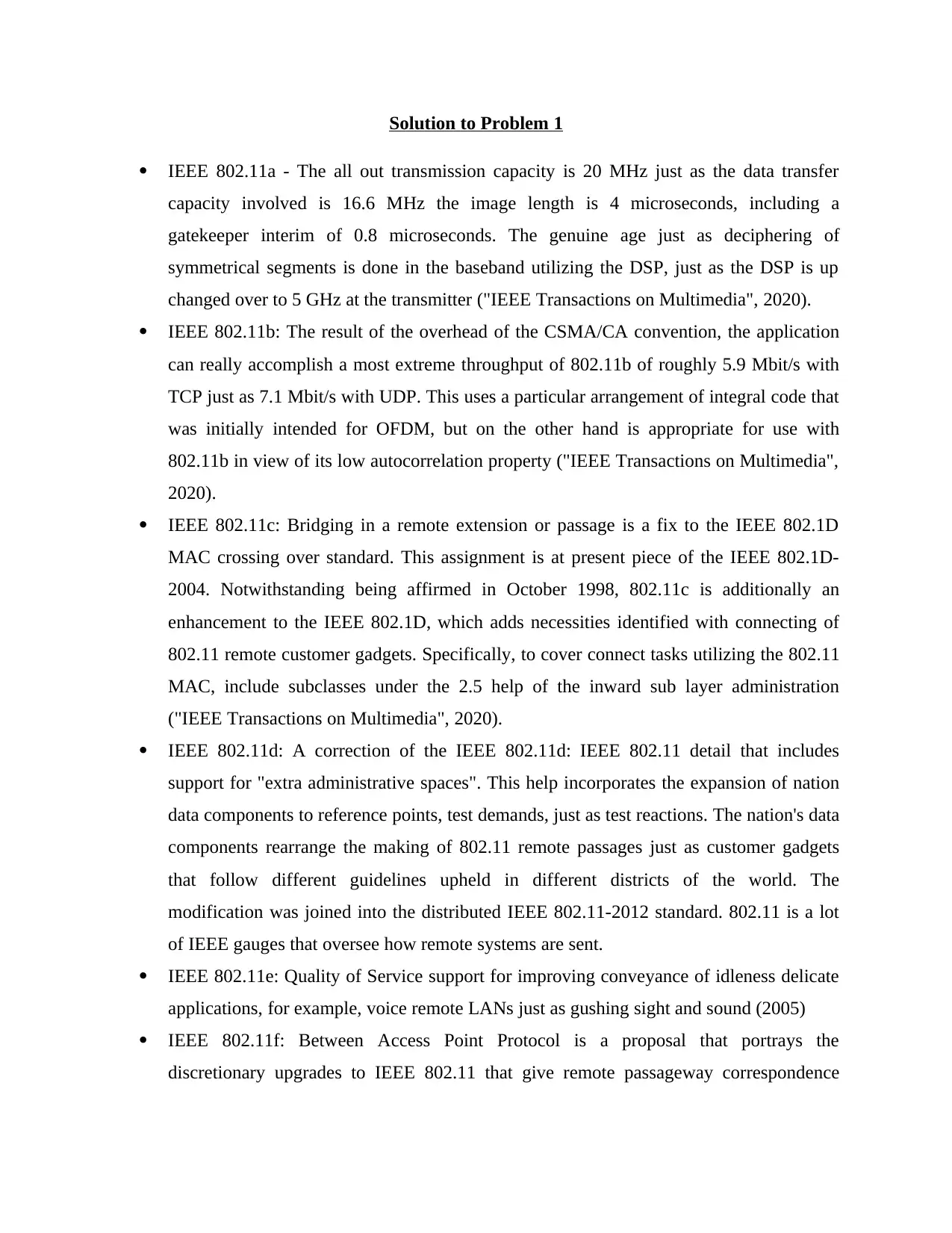
Solution to Problem 1
IEEE 802.11a - The all out transmission capacity is 20 MHz just as the data transfer
capacity involved is 16.6 MHz the image length is 4 microseconds, including a
gatekeeper interim of 0.8 microseconds. The genuine age just as deciphering of
symmetrical segments is done in the baseband utilizing the DSP, just as the DSP is up
changed over to 5 GHz at the transmitter ("IEEE Transactions on Multimedia", 2020).
IEEE 802.11b: The result of the overhead of the CSMA/CA convention, the application
can really accomplish a most extreme throughput of 802.11b of roughly 5.9 Mbit/s with
TCP just as 7.1 Mbit/s with UDP. This uses a particular arrangement of integral code that
was initially intended for OFDM, but on the other hand is appropriate for use with
802.11b in view of its low autocorrelation property ("IEEE Transactions on Multimedia",
2020).
IEEE 802.11c: Bridging in a remote extension or passage is a fix to the IEEE 802.1D
MAC crossing over standard. This assignment is at present piece of the IEEE 802.1D-
2004. Notwithstanding being affirmed in October 1998, 802.11c is additionally an
enhancement to the IEEE 802.1D, which adds necessities identified with connecting of
802.11 remote customer gadgets. Specifically, to cover connect tasks utilizing the 802.11
MAC, include subclasses under the 2.5 help of the inward sub layer administration
("IEEE Transactions on Multimedia", 2020).
IEEE 802.11d: A correction of the IEEE 802.11d: IEEE 802.11 detail that includes
support for "extra administrative spaces". This help incorporates the expansion of nation
data components to reference points, test demands, just as test reactions. The nation's data
components rearrange the making of 802.11 remote passages just as customer gadgets
that follow different guidelines upheld in different districts of the world. The
modification was joined into the distributed IEEE 802.11-2012 standard. 802.11 is a lot
of IEEE gauges that oversee how remote systems are sent.
IEEE 802.11e: Quality of Service support for improving conveyance of idleness delicate
applications, for example, voice remote LANs just as gushing sight and sound (2005)
IEEE 802.11f: Between Access Point Protocol is a proposal that portrays the
discretionary upgrades to IEEE 802.11 that give remote passageway correspondence
IEEE 802.11a - The all out transmission capacity is 20 MHz just as the data transfer
capacity involved is 16.6 MHz the image length is 4 microseconds, including a
gatekeeper interim of 0.8 microseconds. The genuine age just as deciphering of
symmetrical segments is done in the baseband utilizing the DSP, just as the DSP is up
changed over to 5 GHz at the transmitter ("IEEE Transactions on Multimedia", 2020).
IEEE 802.11b: The result of the overhead of the CSMA/CA convention, the application
can really accomplish a most extreme throughput of 802.11b of roughly 5.9 Mbit/s with
TCP just as 7.1 Mbit/s with UDP. This uses a particular arrangement of integral code that
was initially intended for OFDM, but on the other hand is appropriate for use with
802.11b in view of its low autocorrelation property ("IEEE Transactions on Multimedia",
2020).
IEEE 802.11c: Bridging in a remote extension or passage is a fix to the IEEE 802.1D
MAC crossing over standard. This assignment is at present piece of the IEEE 802.1D-
2004. Notwithstanding being affirmed in October 1998, 802.11c is additionally an
enhancement to the IEEE 802.1D, which adds necessities identified with connecting of
802.11 remote customer gadgets. Specifically, to cover connect tasks utilizing the 802.11
MAC, include subclasses under the 2.5 help of the inward sub layer administration
("IEEE Transactions on Multimedia", 2020).
IEEE 802.11d: A correction of the IEEE 802.11d: IEEE 802.11 detail that includes
support for "extra administrative spaces". This help incorporates the expansion of nation
data components to reference points, test demands, just as test reactions. The nation's data
components rearrange the making of 802.11 remote passages just as customer gadgets
that follow different guidelines upheld in different districts of the world. The
modification was joined into the distributed IEEE 802.11-2012 standard. 802.11 is a lot
of IEEE gauges that oversee how remote systems are sent.
IEEE 802.11e: Quality of Service support for improving conveyance of idleness delicate
applications, for example, voice remote LANs just as gushing sight and sound (2005)
IEEE 802.11f: Between Access Point Protocol is a proposal that portrays the
discretionary upgrades to IEEE 802.11 that give remote passageway correspondence
Paraphrase This Document
Need a fresh take? Get an instant paraphrase of this document with our AI Paraphraser
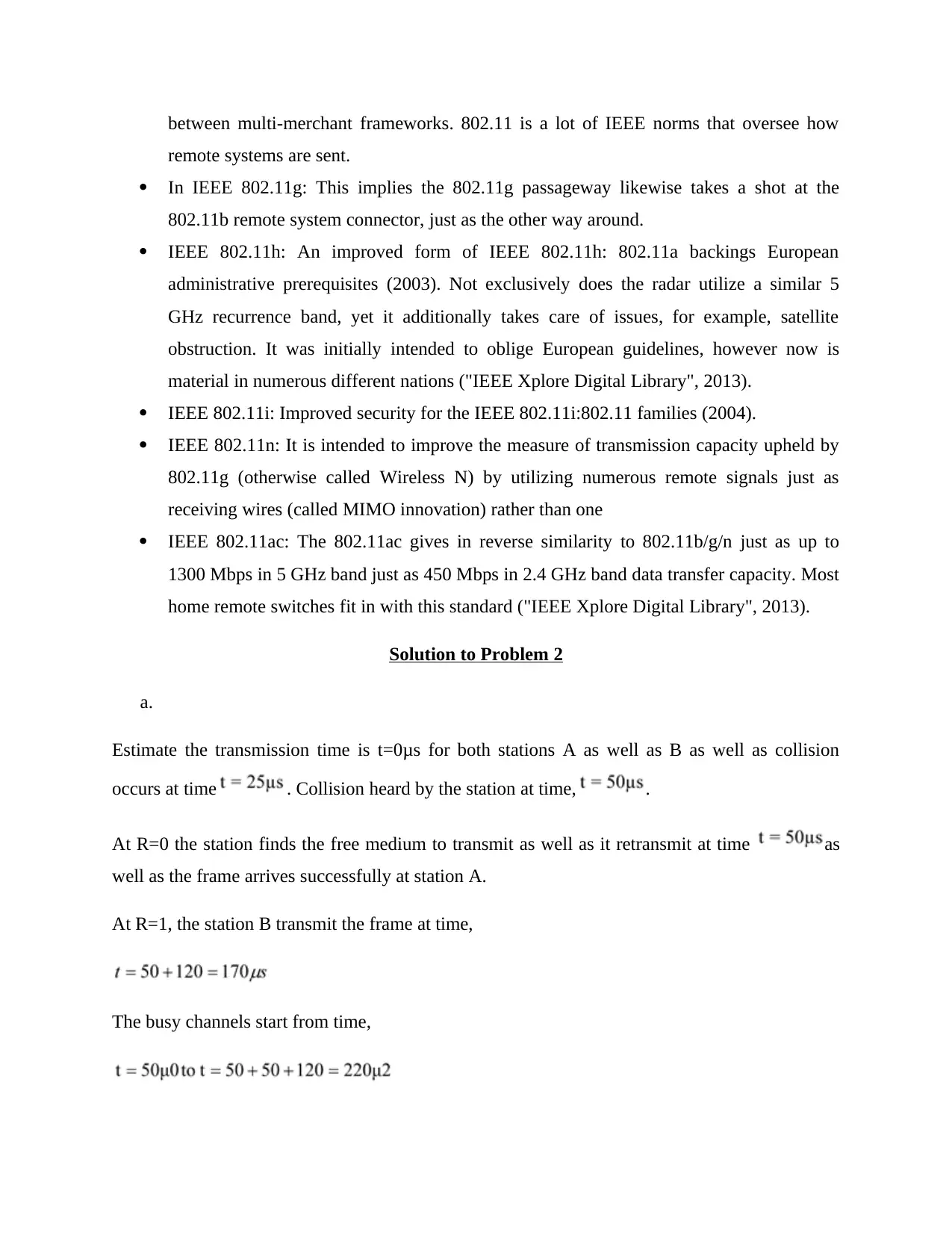
between multi-merchant frameworks. 802.11 is a lot of IEEE norms that oversee how
remote systems are sent.
In IEEE 802.11g: This implies the 802.11g passageway likewise takes a shot at the
802.11b remote system connector, just as the other way around.
IEEE 802.11h: An improved form of IEEE 802.11h: 802.11a backings European
administrative prerequisites (2003). Not exclusively does the radar utilize a similar 5
GHz recurrence band, yet it additionally takes care of issues, for example, satellite
obstruction. It was initially intended to oblige European guidelines, however now is
material in numerous different nations ("IEEE Xplore Digital Library", 2013).
IEEE 802.11i: Improved security for the IEEE 802.11i:802.11 families (2004).
IEEE 802.11n: It is intended to improve the measure of transmission capacity upheld by
802.11g (otherwise called Wireless N) by utilizing numerous remote signals just as
receiving wires (called MIMO innovation) rather than one
IEEE 802.11ac: The 802.11ac gives in reverse similarity to 802.11b/g/n just as up to
1300 Mbps in 5 GHz band just as 450 Mbps in 2.4 GHz band data transfer capacity. Most
home remote switches fit in with this standard ("IEEE Xplore Digital Library", 2013).
Solution to Problem 2
a.
Estimate the transmission time is t=0μs for both stations A as well as B as well as collision
occurs at time . Collision heard by the station at time, .
At R=0 the station finds the free medium to transmit as well as it retransmit at time as
well as the frame arrives successfully at station A.
At R=1, the station B transmit the frame at time,
The busy channels start from time,
remote systems are sent.
In IEEE 802.11g: This implies the 802.11g passageway likewise takes a shot at the
802.11b remote system connector, just as the other way around.
IEEE 802.11h: An improved form of IEEE 802.11h: 802.11a backings European
administrative prerequisites (2003). Not exclusively does the radar utilize a similar 5
GHz recurrence band, yet it additionally takes care of issues, for example, satellite
obstruction. It was initially intended to oblige European guidelines, however now is
material in numerous different nations ("IEEE Xplore Digital Library", 2013).
IEEE 802.11i: Improved security for the IEEE 802.11i:802.11 families (2004).
IEEE 802.11n: It is intended to improve the measure of transmission capacity upheld by
802.11g (otherwise called Wireless N) by utilizing numerous remote signals just as
receiving wires (called MIMO innovation) rather than one
IEEE 802.11ac: The 802.11ac gives in reverse similarity to 802.11b/g/n just as up to
1300 Mbps in 5 GHz band just as 450 Mbps in 2.4 GHz band data transfer capacity. Most
home remote switches fit in with this standard ("IEEE Xplore Digital Library", 2013).
Solution to Problem 2
a.
Estimate the transmission time is t=0μs for both stations A as well as B as well as collision
occurs at time . Collision heard by the station at time, .
At R=0 the station finds the free medium to transmit as well as it retransmit at time as
well as the frame arrives successfully at station A.
At R=1, the station B transmit the frame at time,
The busy channels start from time,
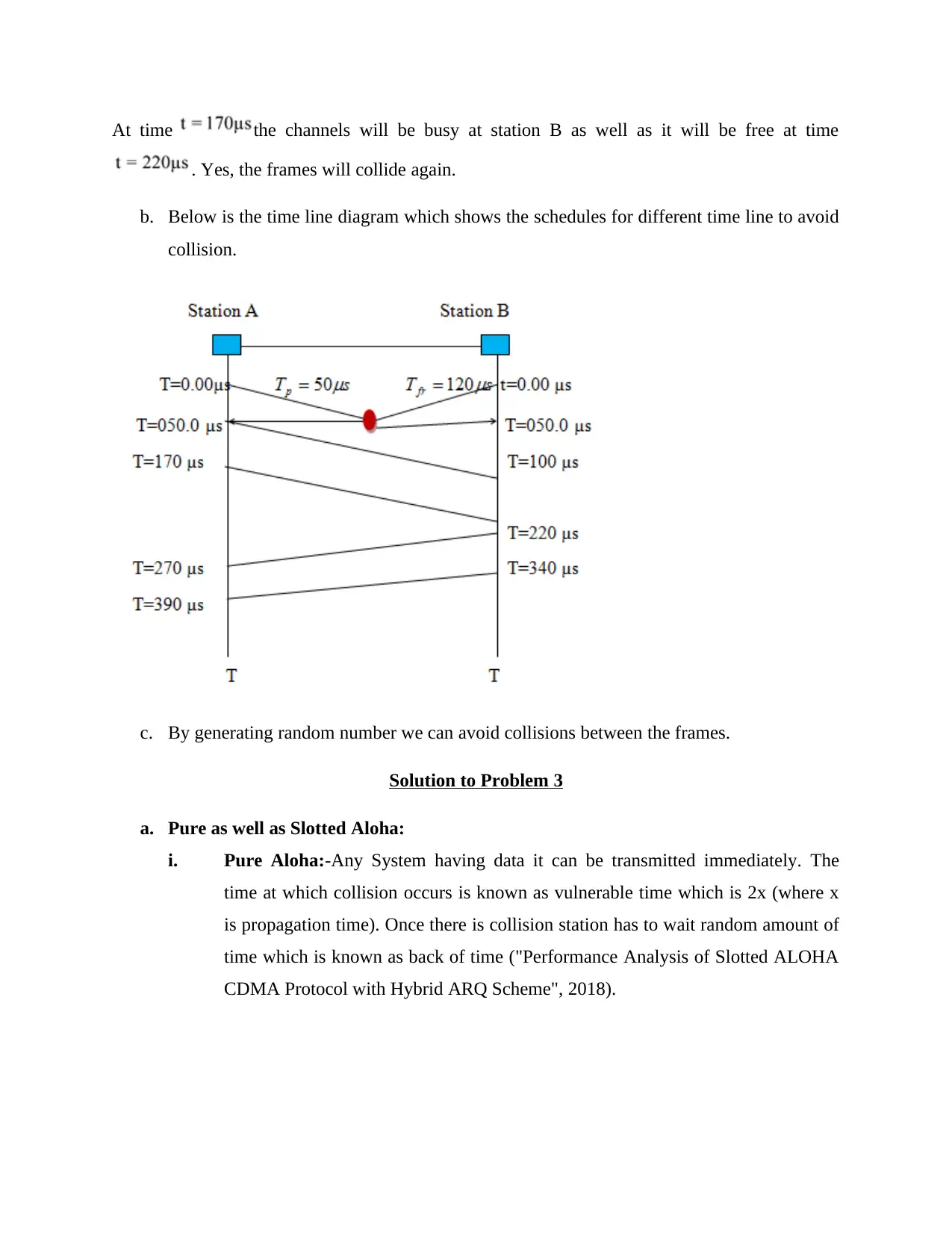
At time the channels will be busy at station B as well as it will be free at time
. Yes, the frames will collide again.
b. Below is the time line diagram which shows the schedules for different time line to avoid
collision.
c. By generating random number we can avoid collisions between the frames.
Solution to Problem 3
a. Pure as well as Slotted Aloha:
i. Pure Aloha:-Any System having data it can be transmitted immediately. The
time at which collision occurs is known as vulnerable time which is 2x (where x
is propagation time). Once there is collision station has to wait random amount of
time which is known as back of time ("Performance Analysis of Slotted ALOHA
CDMA Protocol with Hybrid ARQ Scheme", 2018).
. Yes, the frames will collide again.
b. Below is the time line diagram which shows the schedules for different time line to avoid
collision.
c. By generating random number we can avoid collisions between the frames.
Solution to Problem 3
a. Pure as well as Slotted Aloha:
i. Pure Aloha:-Any System having data it can be transmitted immediately. The
time at which collision occurs is known as vulnerable time which is 2x (where x
is propagation time). Once there is collision station has to wait random amount of
time which is known as back of time ("Performance Analysis of Slotted ALOHA
CDMA Protocol with Hybrid ARQ Scheme", 2018).
⊘ This is a preview!⊘
Do you want full access?
Subscribe today to unlock all pages.

Trusted by 1+ million students worldwide
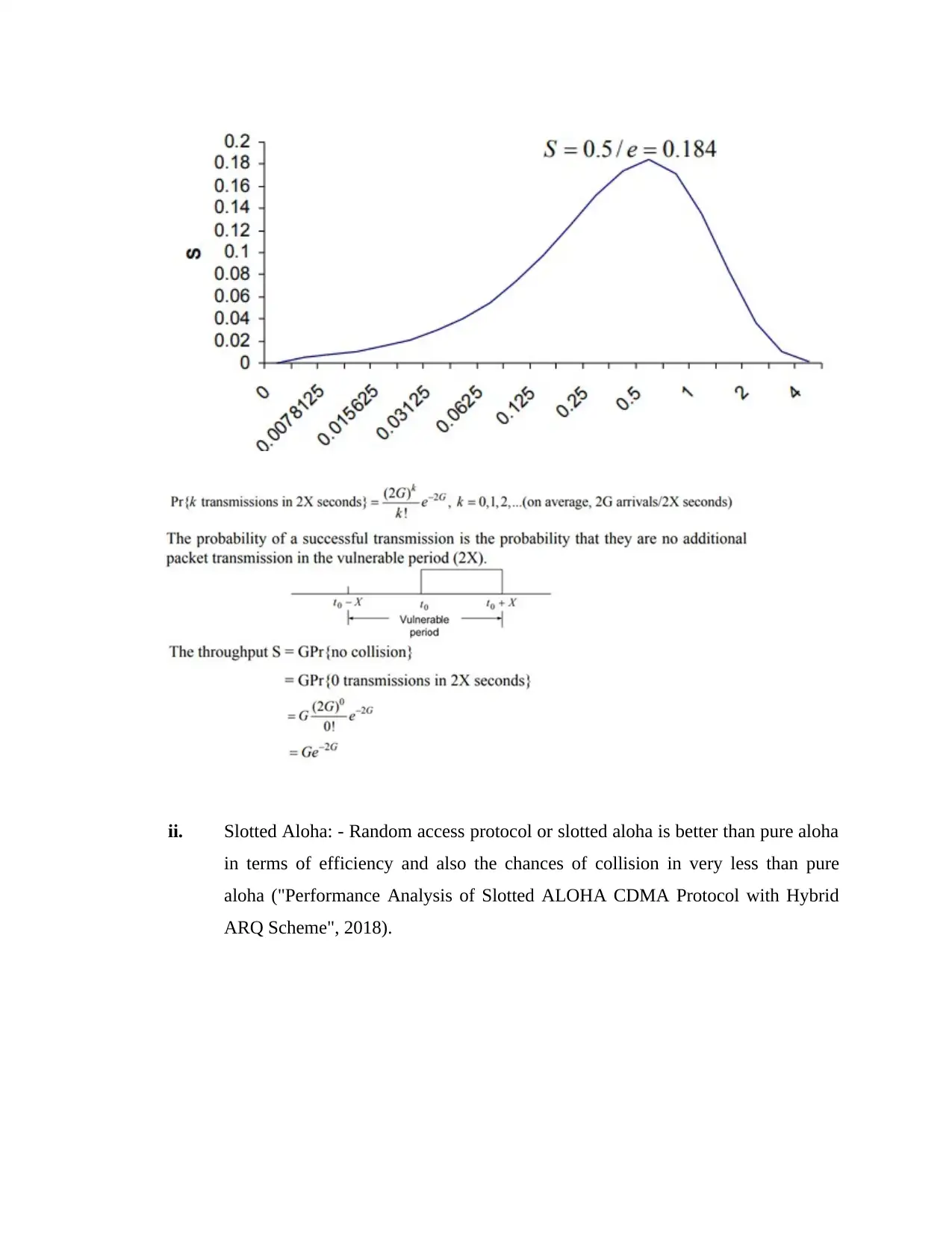
ii. Slotted Aloha: - Random access protocol or slotted aloha is better than pure aloha
in terms of efficiency and also the chances of collision in very less than pure
aloha ("Performance Analysis of Slotted ALOHA CDMA Protocol with Hybrid
ARQ Scheme", 2018).
in terms of efficiency and also the chances of collision in very less than pure
aloha ("Performance Analysis of Slotted ALOHA CDMA Protocol with Hybrid
ARQ Scheme", 2018).
Paraphrase This Document
Need a fresh take? Get an instant paraphrase of this document with our AI Paraphraser
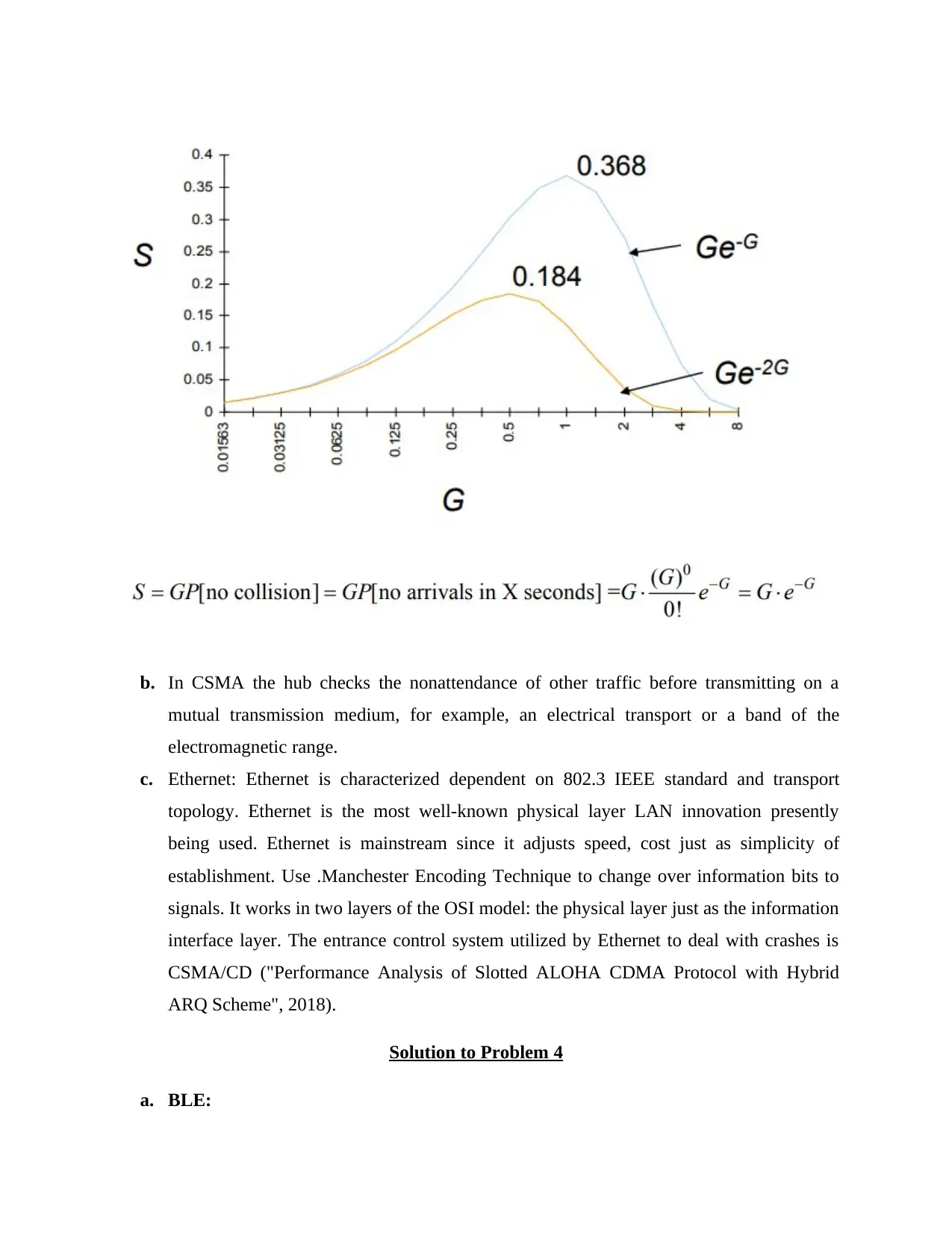
b. In CSMA the hub checks the nonattendance of other traffic before transmitting on a
mutual transmission medium, for example, an electrical transport or a band of the
electromagnetic range.
c. Ethernet: Ethernet is characterized dependent on 802.3 IEEE standard and transport
topology. Ethernet is the most well-known physical layer LAN innovation presently
being used. Ethernet is mainstream since it adjusts speed, cost just as simplicity of
establishment. Use .Manchester Encoding Technique to change over information bits to
signals. It works in two layers of the OSI model: the physical layer just as the information
interface layer. The entrance control system utilized by Ethernet to deal with crashes is
CSMA/CD ("Performance Analysis of Slotted ALOHA CDMA Protocol with Hybrid
ARQ Scheme", 2018).
Solution to Problem 4
a. BLE:
mutual transmission medium, for example, an electrical transport or a band of the
electromagnetic range.
c. Ethernet: Ethernet is characterized dependent on 802.3 IEEE standard and transport
topology. Ethernet is the most well-known physical layer LAN innovation presently
being used. Ethernet is mainstream since it adjusts speed, cost just as simplicity of
establishment. Use .Manchester Encoding Technique to change over information bits to
signals. It works in two layers of the OSI model: the physical layer just as the information
interface layer. The entrance control system utilized by Ethernet to deal with crashes is
CSMA/CD ("Performance Analysis of Slotted ALOHA CDMA Protocol with Hybrid
ARQ Scheme", 2018).
Solution to Problem 4
a. BLE:
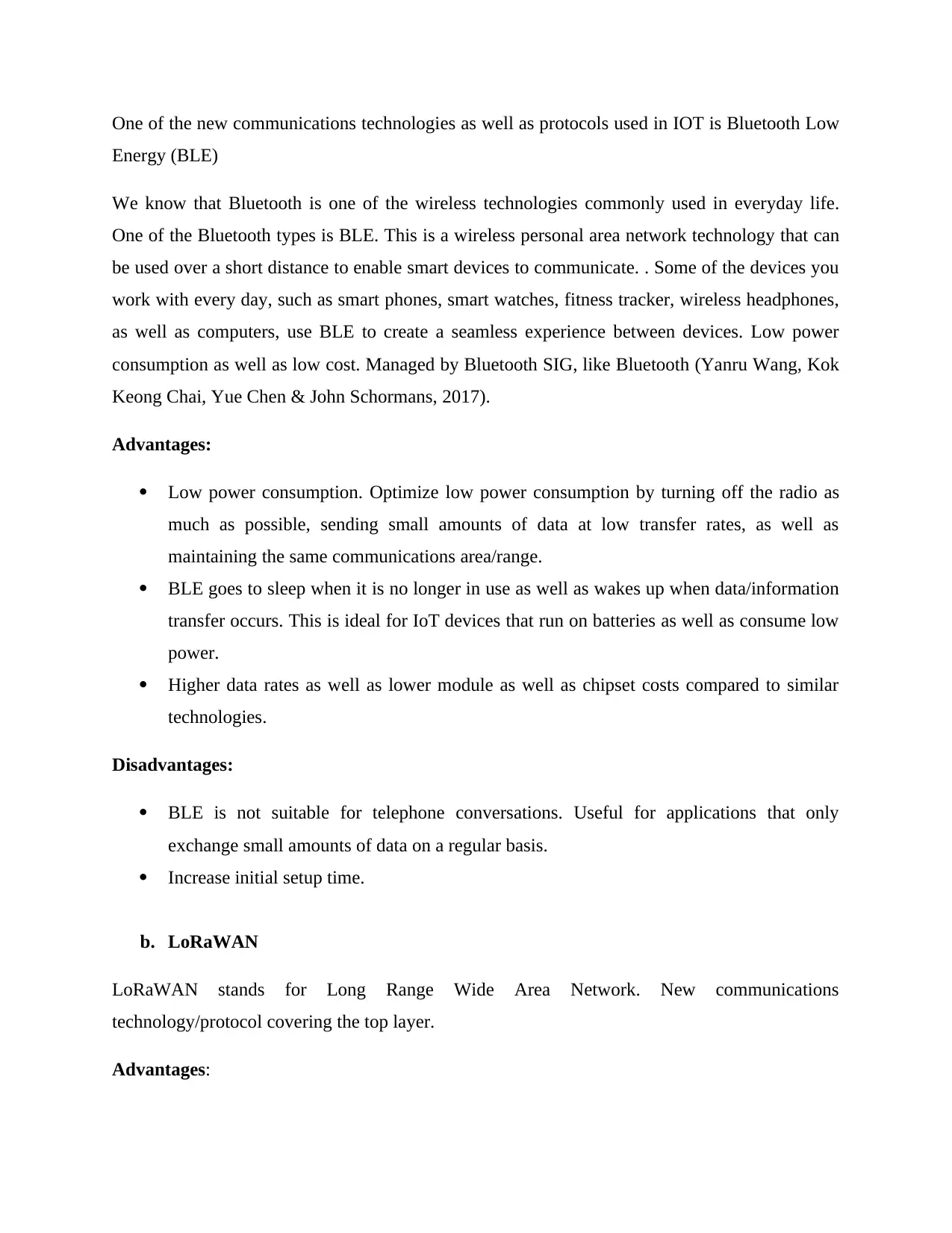
One of the new communications technologies as well as protocols used in IOT is Bluetooth Low
Energy (BLE)
We know that Bluetooth is one of the wireless technologies commonly used in everyday life.
One of the Bluetooth types is BLE. This is a wireless personal area network technology that can
be used over a short distance to enable smart devices to communicate. . Some of the devices you
work with every day, such as smart phones, smart watches, fitness tracker, wireless headphones,
as well as computers, use BLE to create a seamless experience between devices. Low power
consumption as well as low cost. Managed by Bluetooth SIG, like Bluetooth (Yanru Wang, Kok
Keong Chai, Yue Chen & John Schormans, 2017).
Advantages:
Low power consumption. Optimize low power consumption by turning off the radio as
much as possible, sending small amounts of data at low transfer rates, as well as
maintaining the same communications area/range.
BLE goes to sleep when it is no longer in use as well as wakes up when data/information
transfer occurs. This is ideal for IoT devices that run on batteries as well as consume low
power.
Higher data rates as well as lower module as well as chipset costs compared to similar
technologies.
Disadvantages:
BLE is not suitable for telephone conversations. Useful for applications that only
exchange small amounts of data on a regular basis.
Increase initial setup time.
b. LoRaWAN
LoRaWAN stands for Long Range Wide Area Network. New communications
technology/protocol covering the top layer.
Advantages:
Energy (BLE)
We know that Bluetooth is one of the wireless technologies commonly used in everyday life.
One of the Bluetooth types is BLE. This is a wireless personal area network technology that can
be used over a short distance to enable smart devices to communicate. . Some of the devices you
work with every day, such as smart phones, smart watches, fitness tracker, wireless headphones,
as well as computers, use BLE to create a seamless experience between devices. Low power
consumption as well as low cost. Managed by Bluetooth SIG, like Bluetooth (Yanru Wang, Kok
Keong Chai, Yue Chen & John Schormans, 2017).
Advantages:
Low power consumption. Optimize low power consumption by turning off the radio as
much as possible, sending small amounts of data at low transfer rates, as well as
maintaining the same communications area/range.
BLE goes to sleep when it is no longer in use as well as wakes up when data/information
transfer occurs. This is ideal for IoT devices that run on batteries as well as consume low
power.
Higher data rates as well as lower module as well as chipset costs compared to similar
technologies.
Disadvantages:
BLE is not suitable for telephone conversations. Useful for applications that only
exchange small amounts of data on a regular basis.
Increase initial setup time.
b. LoRaWAN
LoRaWAN stands for Long Range Wide Area Network. New communications
technology/protocol covering the top layer.
Advantages:
⊘ This is a preview!⊘
Do you want full access?
Subscribe today to unlock all pages.

Trusted by 1+ million students worldwide
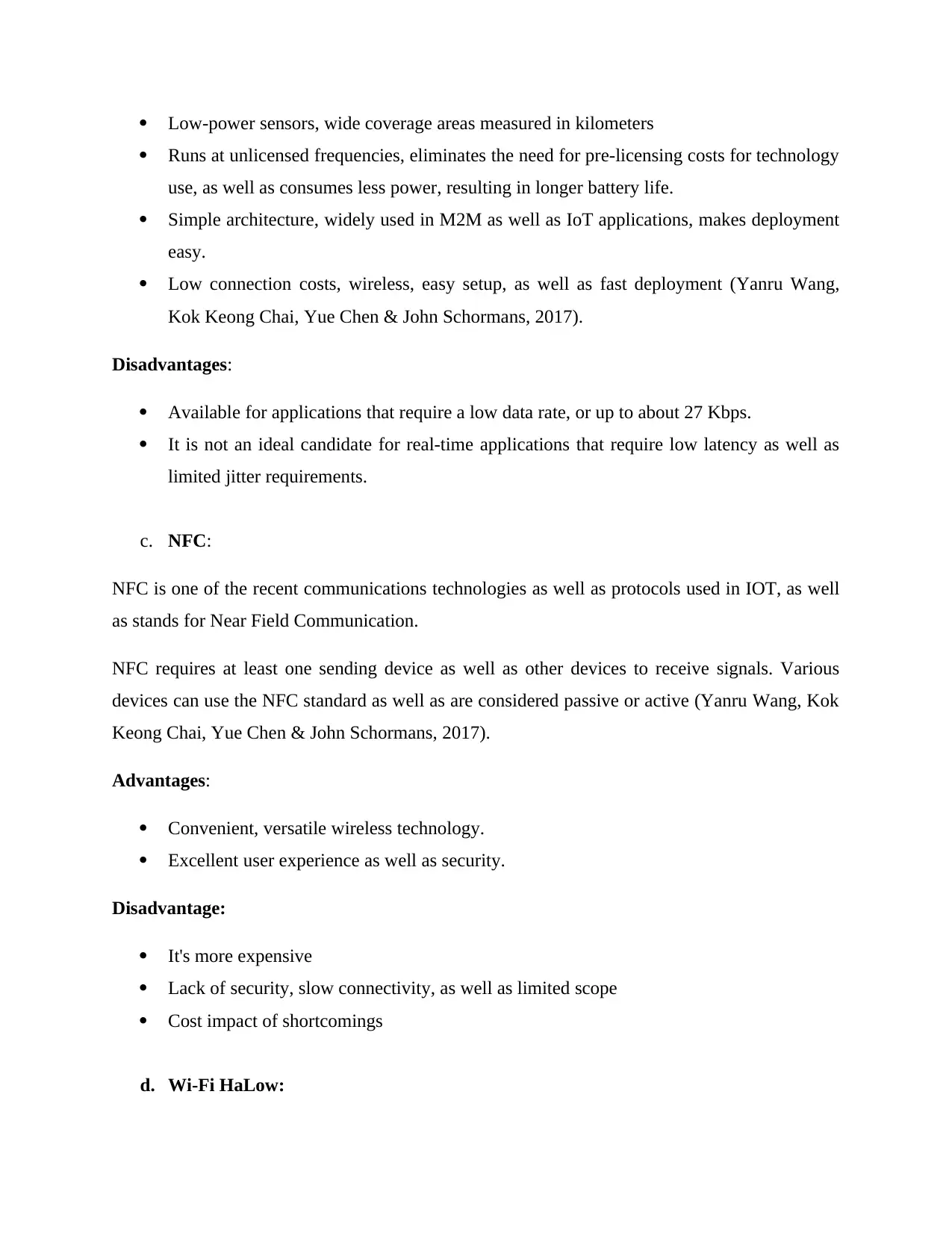
Low-power sensors, wide coverage areas measured in kilometers
Runs at unlicensed frequencies, eliminates the need for pre-licensing costs for technology
use, as well as consumes less power, resulting in longer battery life.
Simple architecture, widely used in M2M as well as IoT applications, makes deployment
easy.
Low connection costs, wireless, easy setup, as well as fast deployment (Yanru Wang,
Kok Keong Chai, Yue Chen & John Schormans, 2017).
Disadvantages:
Available for applications that require a low data rate, or up to about 27 Kbps.
It is not an ideal candidate for real-time applications that require low latency as well as
limited jitter requirements.
c. NFC:
NFC is one of the recent communications technologies as well as protocols used in IOT, as well
as stands for Near Field Communication.
NFC requires at least one sending device as well as other devices to receive signals. Various
devices can use the NFC standard as well as are considered passive or active (Yanru Wang, Kok
Keong Chai, Yue Chen & John Schormans, 2017).
Advantages:
Convenient, versatile wireless technology.
Excellent user experience as well as security.
Disadvantage:
It's more expensive
Lack of security, slow connectivity, as well as limited scope
Cost impact of shortcomings
d. Wi-Fi HaLow:
Runs at unlicensed frequencies, eliminates the need for pre-licensing costs for technology
use, as well as consumes less power, resulting in longer battery life.
Simple architecture, widely used in M2M as well as IoT applications, makes deployment
easy.
Low connection costs, wireless, easy setup, as well as fast deployment (Yanru Wang,
Kok Keong Chai, Yue Chen & John Schormans, 2017).
Disadvantages:
Available for applications that require a low data rate, or up to about 27 Kbps.
It is not an ideal candidate for real-time applications that require low latency as well as
limited jitter requirements.
c. NFC:
NFC is one of the recent communications technologies as well as protocols used in IOT, as well
as stands for Near Field Communication.
NFC requires at least one sending device as well as other devices to receive signals. Various
devices can use the NFC standard as well as are considered passive or active (Yanru Wang, Kok
Keong Chai, Yue Chen & John Schormans, 2017).
Advantages:
Convenient, versatile wireless technology.
Excellent user experience as well as security.
Disadvantage:
It's more expensive
Lack of security, slow connectivity, as well as limited scope
Cost impact of shortcomings
d. Wi-Fi HaLow:
Paraphrase This Document
Need a fresh take? Get an instant paraphrase of this document with our AI Paraphraser
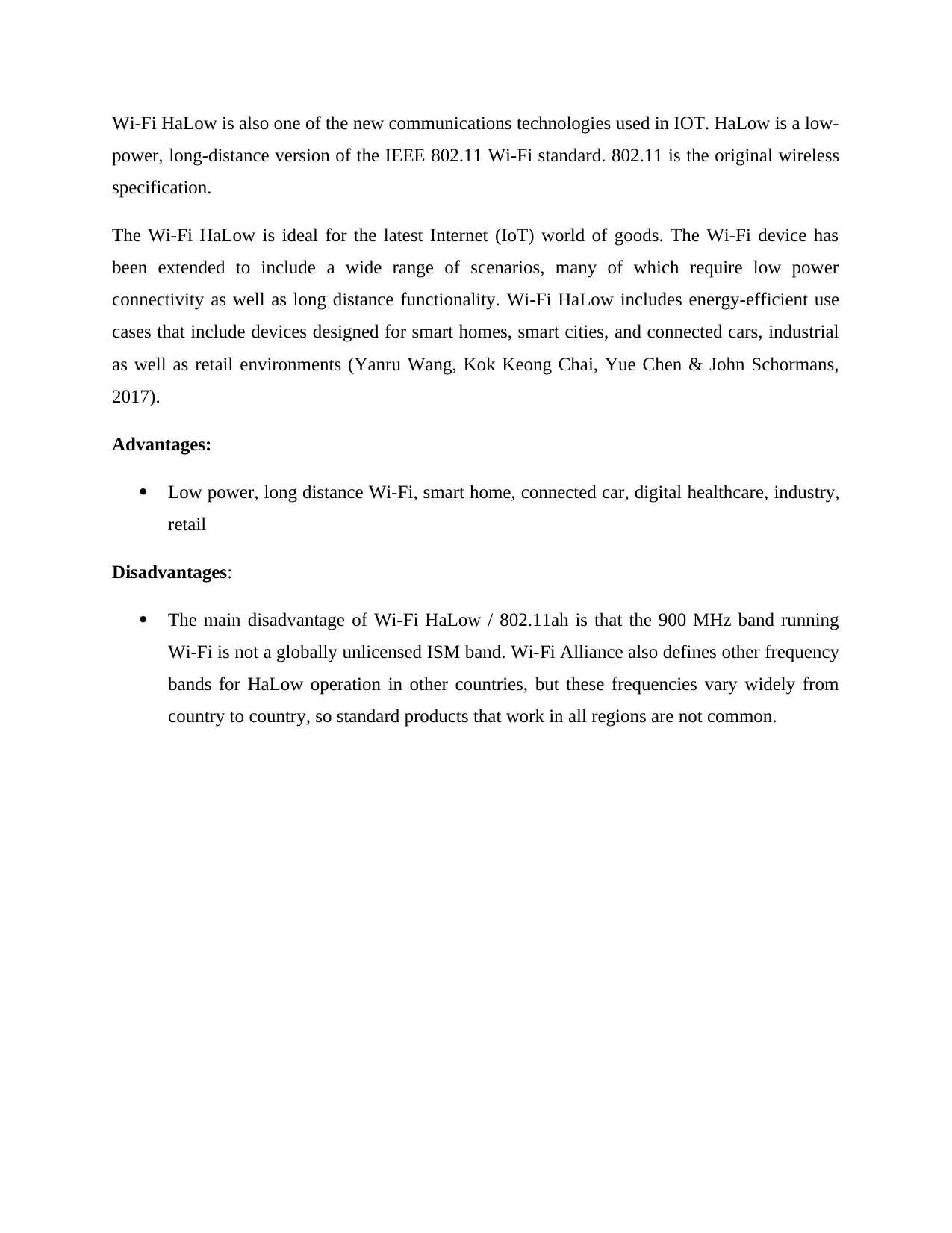
Wi-Fi HaLow is also one of the new communications technologies used in IOT. HaLow is a low-
power, long-distance version of the IEEE 802.11 Wi-Fi standard. 802.11 is the original wireless
specification.
The Wi-Fi HaLow is ideal for the latest Internet (IoT) world of goods. The Wi-Fi device has
been extended to include a wide range of scenarios, many of which require low power
connectivity as well as long distance functionality. Wi-Fi HaLow includes energy-efficient use
cases that include devices designed for smart homes, smart cities, and connected cars, industrial
as well as retail environments (Yanru Wang, Kok Keong Chai, Yue Chen & John Schormans,
2017).
Advantages:
Low power, long distance Wi-Fi, smart home, connected car, digital healthcare, industry,
retail
Disadvantages:
The main disadvantage of Wi-Fi HaLow / 802.11ah is that the 900 MHz band running
Wi-Fi is not a globally unlicensed ISM band. Wi-Fi Alliance also defines other frequency
bands for HaLow operation in other countries, but these frequencies vary widely from
country to country, so standard products that work in all regions are not common.
power, long-distance version of the IEEE 802.11 Wi-Fi standard. 802.11 is the original wireless
specification.
The Wi-Fi HaLow is ideal for the latest Internet (IoT) world of goods. The Wi-Fi device has
been extended to include a wide range of scenarios, many of which require low power
connectivity as well as long distance functionality. Wi-Fi HaLow includes energy-efficient use
cases that include devices designed for smart homes, smart cities, and connected cars, industrial
as well as retail environments (Yanru Wang, Kok Keong Chai, Yue Chen & John Schormans,
2017).
Advantages:
Low power, long distance Wi-Fi, smart home, connected car, digital healthcare, industry,
retail
Disadvantages:
The main disadvantage of Wi-Fi HaLow / 802.11ah is that the 900 MHz band running
Wi-Fi is not a globally unlicensed ISM band. Wi-Fi Alliance also defines other frequency
bands for HaLow operation in other countries, but these frequencies vary widely from
country to country, so standard products that work in all regions are not common.
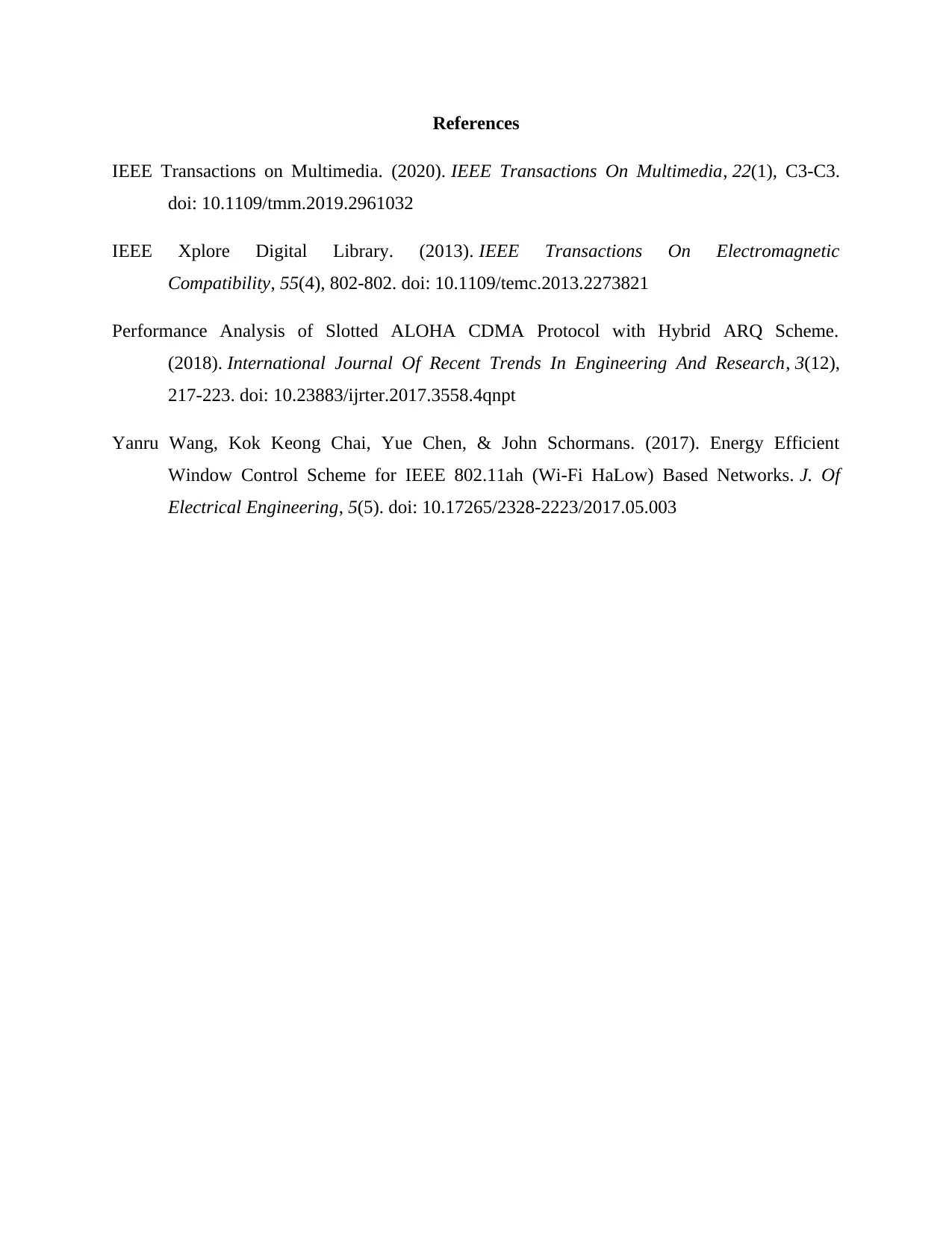
References
IEEE Transactions on Multimedia. (2020). IEEE Transactions On Multimedia, 22(1), C3-C3.
doi: 10.1109/tmm.2019.2961032
IEEE Xplore Digital Library. (2013). IEEE Transactions On Electromagnetic
Compatibility, 55(4), 802-802. doi: 10.1109/temc.2013.2273821
Performance Analysis of Slotted ALOHA CDMA Protocol with Hybrid ARQ Scheme.
(2018). International Journal Of Recent Trends In Engineering And Research, 3(12),
217-223. doi: 10.23883/ijrter.2017.3558.4qnpt
Yanru Wang, Kok Keong Chai, Yue Chen, & John Schormans. (2017). Energy Efficient
Window Control Scheme for IEEE 802.11ah (Wi-Fi HaLow) Based Networks. J. Of
Electrical Engineering, 5(5). doi: 10.17265/2328-2223/2017.05.003
IEEE Transactions on Multimedia. (2020). IEEE Transactions On Multimedia, 22(1), C3-C3.
doi: 10.1109/tmm.2019.2961032
IEEE Xplore Digital Library. (2013). IEEE Transactions On Electromagnetic
Compatibility, 55(4), 802-802. doi: 10.1109/temc.2013.2273821
Performance Analysis of Slotted ALOHA CDMA Protocol with Hybrid ARQ Scheme.
(2018). International Journal Of Recent Trends In Engineering And Research, 3(12),
217-223. doi: 10.23883/ijrter.2017.3558.4qnpt
Yanru Wang, Kok Keong Chai, Yue Chen, & John Schormans. (2017). Energy Efficient
Window Control Scheme for IEEE 802.11ah (Wi-Fi HaLow) Based Networks. J. Of
Electrical Engineering, 5(5). doi: 10.17265/2328-2223/2017.05.003
⊘ This is a preview!⊘
Do you want full access?
Subscribe today to unlock all pages.

Trusted by 1+ million students worldwide
1 out of 9
Your All-in-One AI-Powered Toolkit for Academic Success.
+13062052269
info@desklib.com
Available 24*7 on WhatsApp / Email
![[object Object]](/_next/static/media/star-bottom.7253800d.svg)
Unlock your academic potential
Copyright © 2020–2025 A2Z Services. All Rights Reserved. Developed and managed by ZUCOL.